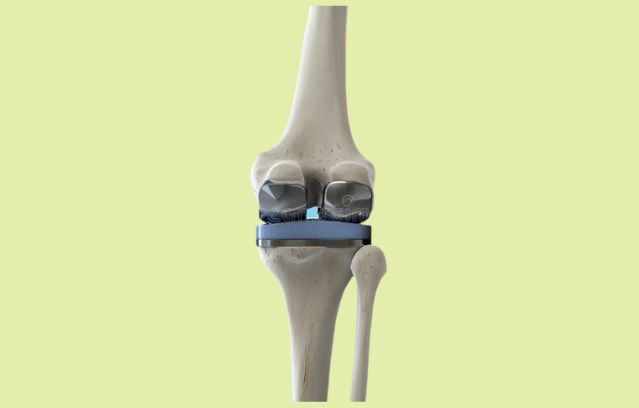
If the knee is damaged by an injury or due to arthritis it will be very difficult to do even daily work. Walking and climbing stairs will be hard. If taking medicines or other manual help will not give a better result then it is good to go for a knee replacement with the suggestion of an orthopedic surgeon. It can reduce pain and can make a person do daily activities without much strain. Knee replacement surgery is also known as arthroplasty. It is done to restore or replace the damaged or diseased knee. If there is any discomfort initially consult an orthopedic surgeon and get proper medical advice. Here is a detailed description of knee replacement.
Understanding Knee
There are three main bones in the knee. First is femur the end of thigh bone, second is patella the kneecap, third is tibia shinbone. Articular cartilage covers all these three vital components. There are C-shaped wedges between tibia and femur which act as shock absorbers. Tibia and femur are held by ligaments and give stability. A thin membrane called synovial membrane releases a lubricating fluid which reduces friction and ensures smooth movement of the knee. Any injury or disease can disturb the functioning of these components which lead to pain and discomfort.
Causes for Knee replacement
The main cause for knee replacement is arthritis. There are three types of arthritis which cause knee damage. They are as given.
- Osteoarthritis
The cartilage that gives comfort to the knee will wear off and soften. Then friction arises between the bones. This leads to pain and stiffening of the knee. This mostly occurs in people 50 years old or more.
- Rheumatoid arthritis
This is a part of a group of arthritis called inflammatory arthritis. In this the synovial membrane which covers the joint swells and thickens. This inflammation can be chronic. It can damage cartilage completely causing stiffness and pain.
- Post-traumatic arthritis
If at all any injury occurs to the knee and gets damaged, this condition might come. If fractures occur to knee bones or ligaments get torn then cartilage gets damaged. This leads to damage of articular cartilage.
If at all suffering with any of the above conditions then consult an orthopedic surgeon or arthroscopic surgeon. To clear any doubts take an online consultation.
About the process of Knee replacement
In this process there are mainly four steps.
- Bone preparation
At the ends of femur and tibia bones the cartilage that is damaged is removed. A little part of the underlying bone is also taken.
- Metal implants positioning
The surface of the joint is recreated by adjusting the metal components in the bone and cartilage places. The metal components can be press-fit into the bone or binded up with cement.
- Patella resurfacing
The beneath part of the kneecap (patella) is cut. A plastic button is resurfaced on it. This is done as per the need and condition of the patient. All does not need this step.
- Spacer insertion
Between the metal components a spacer is inserted. A medical grade plastic spacer is used for smooth gliding surfaces. During any of the above surgeries local anesthesia or general anesthesia is given as per the condition of the patient. An orthopedic surgeon or knee arthroscopic surgeon is consulted for a proper treatment.
Before surgery Diagnosis tests
An orthopedic surgeon or arthroscopic surgeon does a clear assessment of the patient before the surgery. Here are the common tests that are done.
- Initially the general health of the patient is evaluated. The extent of knee pain is assessed.
- A physical examination is done in which the knee functioning is checked thoroughly. Movement, capability to walk or stand are observed.
- Imaging tests like X-ray are recommended. These help to view the damage or deformation that occurred. Condition of the bone and the knee tissues can be seen through MRI scan. So this too can be asked by an orthopedic surgeon.
- Other blood tests to check blood glucose level and clotting time will also be done.
An orthopedic surgeon will evaluate all the results of the tests and discuss the treatment process with the patient.
Types of Knee replacement procedures
There are two main types of knee replacement procedures. They are as given.
- Total knee replacement
Thanks to the advancements in the medical field, there are custom fit knee implants which can efficiently replace original knee parts. Total knee replacement is arthritis safest and effective among all orthopedic surgeries. All the above said stages are done in this process. It is a traditional way and is mostly used as a partial knee replacement technique.
- Partial knee replacement
This is also known as unicompartmental knee replacement. This is done in very few cases. In this only the affected area is removed and the healthy part is left intact. This is only done in accident cases or post traumatic arthritis or if only one component of the bone is damaged.
An orthopedic surgeon or an arthroscopic surgeon will clearly assess the situation of the patient and advise which is apt for the patient.
Pre and post precautions of Knee replacement surgery
Do not freak out by hearing the word surgery. Medical field has advanced a lot. By following a few precautions everything goes smoothly.
- If the patient has diabetes or blood pressure they are to be managed initially. For this the diet is to be checked and unnecessary thinking is to be avoided.
- If the patient has a smoking habit or alcohol consumption they are to be avoided or at least minimized. Because tobacco content can interfere with medication and delays healing.
- Once the surgery date is fixed, start to check your diet. One must not gain weight in between.
- Make sure that there will be a person to look after you post surgery.
The above are pre surgery precautions. Here are the post surgery precautions.
- Avoid bending and squatting. In the washroom use an anti slip mat. Take care of your clothes so that they are comfortable and do not make movement difficult.
- While sitting, choose a better place like a sofa or a chair that is comfortable. Make sure that there is a back rest. Do not sit for more than half an hour constantly.
- Only do the work suggested by an orthopedic surgeon or arthroscopic surgeon. Avoid climbing stairs or strenuous activities for a certain period of time.
- Use the medication prescribed by the doctor properly. Do not skip.
Post surgery of Knee replacement
Knee replacement is done to ensure a normal life again. So to achieve it once the surgery is done, an orthopedic surgeon will suggest physiotherapy. At least 20-30 minutes of exercise will be advised. Always do the exercises as suggested by the physiotherapist. Exercises will be prescribed to avoid blood clots and strengthen the knee muscles. Also the muscles get adjusted in the sockets and movement becomes easier. There will be discomfort in the beginning. But do not skip stating this reason. Do the exercises regularly without fail. The movement is needed to increase blood flow which prevents swelling. Also medications will be prescribed by an orthopedic surgeon. Pain killers will be given. Be careful not to wet the knee. It might lead to infection. Most cases the knee replacement is successful and those who do can lead a normal life. Try to avoid any activity that shows impact on the knee. Weight lifting or jumping and twisting are a big no. Those activities can pressurize knee components which can lead to failure of the surgery. Always follow doctor instructions.


